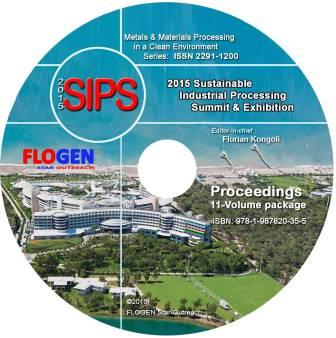2015-Sustainable Industrial Processing Summit
SIPS 2015 Volume 6: Coatings, Cement, Rare Earth & Ferro-alloys
| Editors: | Kongoli F, Yildirim H, Hainer S, Hofmann K, Proske T, Graubner C.A., Albert B |
| Publisher: | Flogen Star OUTREACH |
| Publication Year: | 2015 |
| Pages: | 200 pages |
| ISBN: | 978-1-987820-29-4 |
| ISSN: | 2291-1227 (Metals and Materials Processing in a Clean Environment Series) |

< CD shopping page
Trends and Developments in Green Cement and Concrete Technology
Alasana Drammeh1; Omar Sidibeh2;1DRAMMEH TRADING COMPANY, Banjul, Gambia, The; 2GACEM CEMENT GAMBIA, Banjul, Gambia, The;
Type of Paper: Regular
Id Paper: 500
Topic: 9
Abstract:
The cement industry faces a number of challenges that include depleting fossil fuel reserves, scarcity of raw materials, perpetually increasing demand for cements and concretes, growing environmental concerns linked to climate change and an ailing world economy. Every tonne of Ordinary Portland Cement (OPC) that is produced releases on average a similar amount of CO2 into the atmosphere, or in total roughly 6% of all man-made carbon emissions. Improved production methods and formulations that reduce or eliminate CO2 emissions from the cement manufacturing process are thus high on the agenda. Emission reduction is also needed to counter the impacts on product cost of new regulations, green taxes and escalating fuel prices. In this regard, locally available minerals, recycled materials and (industry, agriculture and domestic) waste may be suitable for blending with OPC as substitute, or in some cases replacement, binders. Fly ash, Blast furnace slag and silica fumes are three well known examples of cement replacement materials that are in use today that, like OPC, have been documented and validated both in laboratory tests and in practice. The first is a by-product of coal combustion, the second of iron smelting and the third of electric arc furnace production of elemental silicon or ferro silicon alloys. This paper presents a concise review of the current state-of-the-art and standards underpinning the production and use of OPC-based cements and concretes. It outlines some of the emerging green alternatives and the benefits they offer. Many of these alternatives rely on technological advances that include energy-efficient, low carbon production methods, novel cement formulations, geopolymers, carbon negative cements and novel concrete products. Finally, the economics of cement production and the trends in the GAMBIA and AFRICA Region are presented, to help guide and inform future developments in cement production based on maximizing the value of carbon reduction